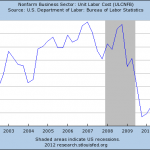Most investors focused today on the employment report from ADP which showed a gain of over 200k jobs. The more interesting – and I think significant – report came 15 minutes later when the BLS released revised figures for 4th quarter productivity and unit labor costs. From Econoday:
Productivity growth for the fourth quarter was bumped up slightly and in line with the recent upward revision to GDP. Nonfarm business productivity gained an annualized 0.9 percent in the fourth quarter, compared to the initial estimate of 0.7 percent and compared to 1.8 percent in the previous quarter (previously 1.9 percent). The market median forecast was for 0.9 percent for the latest period. Unit labor costs were revised up notably to an annualized 2.8 percent increase versus the initial figure of 1.2 percent, and following a 3.9 percent jump in the third quarter (previously down 2.1 percent). The consensus projected a 1.2 percent rise.
Compensation rose an annualized 3.7 percent after a 5.7 percent boost in the third quarter.
For the latest quarter, the upward revision to productivity largely reflected a higher estimate for output and a downward revision to hours worked. The upward revision to unit labor costs was primarily due to a higher estimate for compensation.
Year-on-year, productivity was up 0.3 percent in the fourth quarter, compared to 0.5 percent in the prior quarter. Year-ago unit labor costs were up 3.1 percent, compared to a rise of 2.0 percent in the third quarter.
Productivity gains continue but at a modest pace. And compensation costs have been growing faster than earlier believed. This combination is not conducive for stronger job growth. Again, productivity and employment need stronger output.
The Keynesians have told us repeatedly that we don’t have to worry about inflation because of the “output gap”. They believe that with unemployment this high, inflation can’t possibly be a problem. How could wages rise with so many unemployed? And if wages can’t rise – they say – we can’t get inflation. Of course, that view of the world ignores a plethora of evidence to the contrary but evidence, shmevidence, if you want the government to spend a bunch of money or if you want the Fed to inflate, it is probably best to stick to models and ignore all the data that contradicts your world view.
What the Keynesians aren’t considering is that their aggregate, macro view of the world leaves out a whole bunch of pertinent information. For instance, in this recession we know that the largest fraction of the unemployed came from real estate related industries. If we “stimulate” the economy with fiscal or monetary policy – and we’ve done both – we can create economic activity. What we can’t do is create specific activity in the real estate and real estate related categories. So, when stimulus creates activity in other sectors, it does nothing to help the people out of work who don’t have the necessary skills to work in those sectors. What it does instead is increase the demand for workers in other sectors where unemployment is not as severe and with increased demand comes higher wages.
Just as one example that pops to mind, consider oil field workers in North Dakota. Monetary stimulus has pushed up the price of oil and the demand for oil field workers to drill wells in North Dakota where it is – at least for now – profitable to drill for oil again. With the increased demand for oil field workers the wages of those workers has risen. Stimulus hasn’t done anything for the real estate related workers who are still out of work since they can’t – or won’t – work in oil fields. And so contrary to the Keynesian view of the world, we still have high unemployment and now we also have rising wages and soon an inflation problem.
Another example is the lack of skilled manufacturing workers (Washington Post):
The shortage of skilled workers has also pushed up wages, though executives said raising them too far could push more work to overseas plants.
A Michigan company that makes camshafts for cars, as well as farm and mining equipment, has had ads out for at least six months for CNC machine operators and programmers. The pay runs from $15 to $21 an hour, a relatively good wage in this part of the country.
“The problem is as soon as we get someone in, one of our other guys will jump ship,” said Tyson De Jonge, engineering manager at Engine Power Components. “They get better offers.”
One of the bright spots of the recovery has been the rise in exports as a lower dollar has made US goods more competitive. Unfortunately, carpenters can’t be retrained quickly to become machine tool operators. So the monetary stimulus has raised wages while unemployment remains high.
Labor is not homogenous and policies that ignore that reality are doomed to fail. In this case, we now have high unemployment, rising wages and soon higher inflation. As Econoday says, that isn’t an environment conducive to stronger job growth.



Stay In Touch